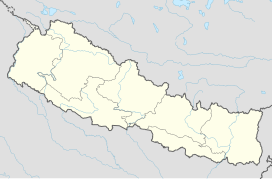The Chatra Gorge is a canyon cut by the Kosi River across the Mahabharat Range in Nepal.
| Chatra Gorge | |
|---|---|
| Length | 10 kilometres (6.2 mi) N-S |
| Width | 5 to 8 kilometres (3.1 to 5.0 mi) |
| Geography | |
| Coordinates | 26°52′07″N 87°09′07″E / 26.86856°N 87.15185°E |
Kosi river system
editThe Kosi, or Sapt Kosi, drains eastern Nepal. It is known as Sapt Koshi because of the seven rivers which join together in east-central Nepal to form this river. The main rivers forming the Kosi system are – the Sun Kosi, the Indravati River, the Bhote Koshi, the Dudh Kosi, the Arun River, Barun River, and Tamur River. The combined river flows through the Chatra gorge in a southerly direction to emerge from the hills.[1][2]
The Sun Kosi contributes 44 per cent of the total water in the Sapta Koshi, the Arun 37 per cent and the Tamur 19 per cent.[3]
Of the rivers that form the Sapta Kosi, the three main tributaries, Sun Kosi, Arun and Tamur converge at Tribeni and enter Chatra Gorge.[4]
The Gorge
editThe Chatra Gorge is about 10 km long and is about 5–8 km wide. Downstream of the gorge, the river enters the alluvial plains forming a huge megafan covering around 16,000 km2.[4][5]
The gorge is located at 26°52′07″N 87°09′07″E / 26.86856°N 87.15185°E. The initial or northern portion of the gorge is at an altitude of 115 metres (377 ft).[6]
Sapta Kosi High Dam
editA 269 metres (883 ft) high dam is proposed to be built near Barahakshetra across the Sapta Kosi in the Chatra gorge. It will have a 3,000 MW power station and a barrage 8 km downstream with canals on both sides for irrigation.[7][8][9]
References
edit- ^ Negi, Sharad Singh (1991). Himalayan rivers, lakes and glaciers. Indus. ISBN 9788185182612. Retrieved 2012-03-01.
{{cite book}}:|work=ignored (help) - ^ Bahadur, Jagdish (2004). Himalayan snow and glaciers: associated environmental problems, progress. Concept Publishing Company. ISBN 9788180690914. Retrieved 2012-03-01.
{{cite book}}:|work=ignored (help) - ^ K.L.Rao (1979). India's Water Wealth. Orient Blackswan. ISBN 9788125007043. Retrieved 2012-03-01.
{{cite book}}:|work=ignored (help) - ^ a b Harbhajan Singh, B. Parkash and K. Gohain. "Facies analysis of the Kosi megafan deposits" (PDF). p. 88. Sedimentary Geolo~, 85 (1993) 87-113 87 Elsevier Science Publishers B.V., Amsterdam. Archived from the original (PDF) on 2016-03-05. Retrieved 2012-03-01.
- ^ "Anatomy of a flood, Kosi, India, 2008". scribd. Retrieved 2012-03-01.
- ^ Tom Woodhatch, "Nepal Handbook", p. 167, Footprint, ISBN 0658000160
- ^ "India-Nepal Treaty". Ministry of Water Resources, Government of India. Archived from the original on 2012-03-11. Retrieved 2012-03-01.
- ^ "India, Nepal fast-track Sapta-Kosi power project". The Indian Express, 17 February 2012. Retrieved 2012-03-01.
- ^ "Interlinking of rivers". Archived from the original on 2013-04-14. Retrieved 2012-03-01.
